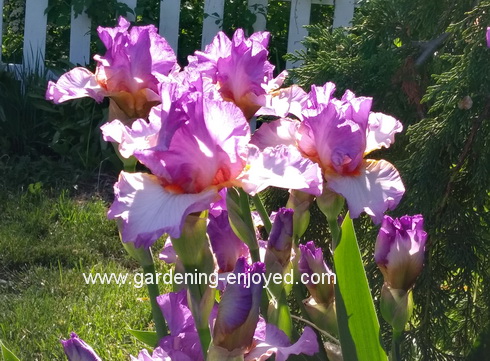
Iris! Iris! Yes I enjoy growing a host of vegetables but all my horticultural fantasies are found in the first weeks of June when the Iris are in bloom. They have been my favourite flower for many years and the garden has a rotating collection that is usually near 100 varieties. Besides the amazing colours and flower form, many of them also have a delightful sweet fragrance. I know the names of many of them but labels tend to disappear, partly because they get dug and divided every 5 - 6 years and keeping labels with them when they move is apparently difficult for me to do. The picture is, I believe, Conjuration but it has been unlabelled for a while so I cannot guarantee that name. Internet sources seem to indicate a bluer colour rather than the deep mauve that my clump is showing this year but it is a delight whoever it may be. This picture was captured in the early evening when the sun was dropping
behind them and giving them this wonderful backlighting. Yes, there is the little problem with the ugly and destructive Iris borer but even he/she cannot deter me from this love affair. I know, I have babbled on too long anout Iris, so I will move on.
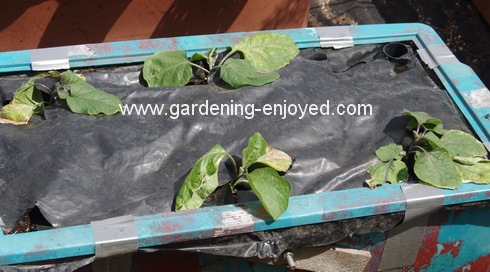
The 24th of May is supposed to be our frost free date here in my little corner of the world and as the temperatures had been around 30 C for several days I was anxious to get the tender vegetables into the soil. Three days later Mother Nature slapped me upside the head and let a few snow flakes and the air temperature drift down. Several things were suffering by the next morning and these Cucumbers were in a desperate state. By mid day the bigger leaves had turned white and crispy leaving some tiny hope that the growing point had survived. My propensity for growing far too many seedlings saved the day. I still had enough surplus Cukes in the cold frame to replant this container. Plant’s adaptions always fascinate me and the Melons just a couple of meters away seemed to be relatively unaffected??????
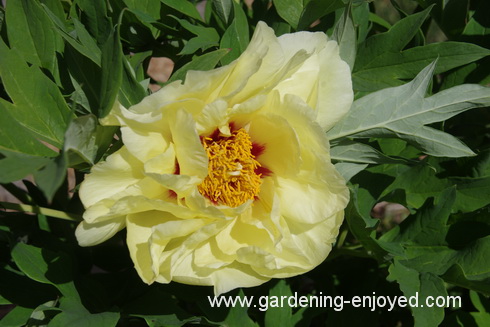
In the fall of 2019 I was at a local garden centre searching for bargains and spotted this beauty. This is a tree Peony named High Noon and she was on for half price. How could I resist, especially since yellow is an uncommon colour in any Peony. Last year she put on an such an amazing amount of new growth that I was concerned that it may have been the root stock or something but this year she has produced an abundance of these large yellow blooms. Apparently High Noon has a habit of letting her blooms droop a bit rather than holding them firmly upright but they are still beautiful and quite easy to see. I love it when a bargain plant decides to perform so well.
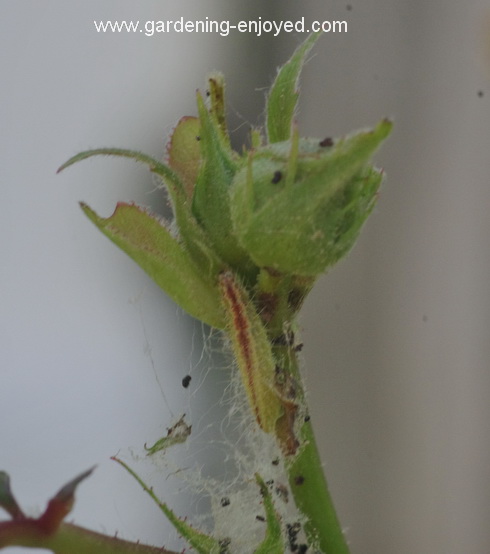
I like to alternate good and not so good stories in “Dallying” so here is an ugly creature that has been in abundance in my garden this spring. Rose bud worm, Pyrrhia umbra, is not big but its damage can be. They hide in the sepals covering the emerging bud and are most readily detected by the white webbing and bits of black excrement that they leave attached to that webbing. The caterpillar eats right into the developing Rose bud so that when it opens it is a well chewed mess. My cure is a regular close up inspection of my Roses and then a gentle prying open of their hiding spot followed by the satisfying squishing with my ever handy needle nose pliers. There is a related beast the Tobacco bud worm, Helicoverpa virenscens, who does not confine himself to Tobacco but like many has given it up in favour of Roses and other flowers. Having researched both I think mine is the Rose bud worm but they are quite similar. If we don’t kill the creatures they
will eventually fall to the soil and pupate and then emerge as an egg laying moth a short while later and apparently they can produce several generations in a season. Don’t think you have killed them all as they may make a return visit in a few weeks. Mother nature does her best to keep me learning new things and she can stop anytime.
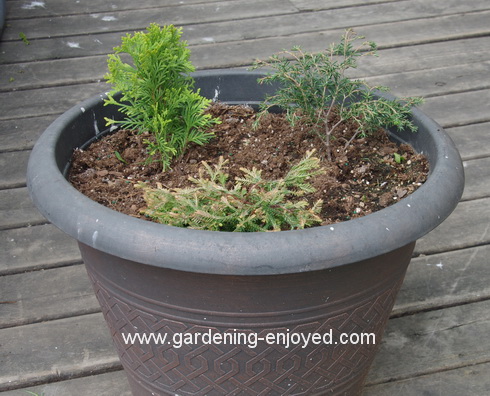 Container gardening has always been a rather seasonal affair lacking any of the winter interest that ground based gardeners get from flowering shrubs and Evergreens. I have toured Iseli Nurseries , in Oregon and admired the many varieties of dwarf evergreens that they produce and always thought they might make a good container that would survive winter in my part of the world. They have been difficult to find on my side of the border until this spring when my local garden centre, Vandermeers in Ajax, surprised me with a selection of them. I chose three that had the coldest zone rating on the label and created this container. Now?? Will it survive the winter?? I don’t want to cover it too much as that defeats the purpose of having a winter container. Maybe a little mulch on the soil and some shelter from the hot spring sun. Stay tuned for updates on this experiment.
Container gardening has always been a rather seasonal affair lacking any of the winter interest that ground based gardeners get from flowering shrubs and Evergreens. I have toured Iseli Nurseries , in Oregon and admired the many varieties of dwarf evergreens that they produce and always thought they might make a good container that would survive winter in my part of the world. They have been difficult to find on my side of the border until this spring when my local garden centre, Vandermeers in Ajax, surprised me with a selection of them. I chose three that had the coldest zone rating on the label and created this container. Now?? Will it survive the winter?? I don’t want to cover it too much as that defeats the purpose of having a winter container. Maybe a little mulch on the soil and some shelter from the hot spring sun. Stay tuned for updates on this experiment.
I have become quite comfortable doing
my presentations on Zoom and one of the big advantages is the ability to speak to groups that are too far away to travel to. I will admit to missing the feel of a live audience but we will continue to Zoom to your meetings as long as we have to. Maybe the long distance capability will be one of the few positive things to develop out of this pandemic. If your group is looking for a knowledgeable and entertaining speaker, check out my web site’s, speaker page.
To ask a question just “reply” to this ezine. Don’t forget to check the front page of the Website for frequent short ideas for current gardening activities.
Patricia Asks? I have prepared my own container mix this year for flowers and the odd vegetable, using ~50% garden soil, 30% soilless mix, and 20% compost. Can this mixture be reused next summer, maybe
with the addition of a bit of fresh compost? I thought of storing it over winter in bags after the containers are emptied and cleaned in late fall.
I’ve noticed the pre-mixed commercial blends for containers vary in quality from year to year, plus they cost a fortune! I’m trying this mixture out to see if it will hold water better, and give more nutrients to the plants while being light enough for proper air, than what I’ve bought in the past.
Ken Answers! I use a commercial soil-less mix in all of my containers because it's easy to use and is sterile so that I don't incorporate any weeds or pathogens by using garden soil. It may seem somewhat expensive on purchase but I reuse that soil for many years. Most large garden centres will have bales of compressed soil-less mix that will be less expensive. It just stays in some of my containers over winter and others I dump out and store in large garbage containers.
Your mix with it's high content of garden
soil may be problematic. It may turn quite hard and without some additional granular such as Perlite making its water absorption difficult. I never worry about the nutrient value of my soil-less mix as I add some soluble fertilizer with every watering.
Kathy Asks? You mentioned spraying squash plants with 1:9 milk to water solution.
When do you apply this treatment? Is it preventative or do you apply after the mildew appears?
Ken Answers! Watch for tiny white dots, which is the beginning of the mildew infection and then spray.
Larke Asks? I've heard that if a variegated plant sends up an all green shoot, the shoot needs to be removed or the entire plant will gradually turn into a solid green. Do you know if this is true?
Ken Answers! Yes you should remove the all green shoots. The variegated shoots will not actually turn green but the green shoot will grow much more quickly and will overtake the others and
become the dominant type. Sharpen your pruners and get busy:-)
|

 Container gardening has always been a rather seasonal affair lacking any of the winter interest that ground based gardeners get from flowering shrubs and Evergreens. I have toured Iseli Nurseries , in Oregon and admired the many varieties of dwarf evergreens that they produce and always thought they might make a good container that would survive winter in my part of the world. They have been difficult to find on my side of the border until this spring when my local garden centre, Vandermeers in Ajax, surprised me with a selection of them. I chose three that had the coldest zone rating on the label and created this container. Now?? Will it survive the winter?? I don’t want to cover it too much as that defeats the purpose of having a winter container. Maybe a little mulch on the soil and some shelter from the hot spring sun. Stay tuned for updates on this experiment.
Container gardening has always been a rather seasonal affair lacking any of the winter interest that ground based gardeners get from flowering shrubs and Evergreens. I have toured Iseli Nurseries , in Oregon and admired the many varieties of dwarf evergreens that they produce and always thought they might make a good container that would survive winter in my part of the world. They have been difficult to find on my side of the border until this spring when my local garden centre, Vandermeers in Ajax, surprised me with a selection of them. I chose three that had the coldest zone rating on the label and created this container. Now?? Will it survive the winter?? I don’t want to cover it too much as that defeats the purpose of having a winter container. Maybe a little mulch on the soil and some shelter from the hot spring sun. Stay tuned for updates on this experiment.


